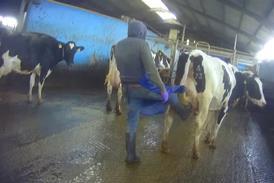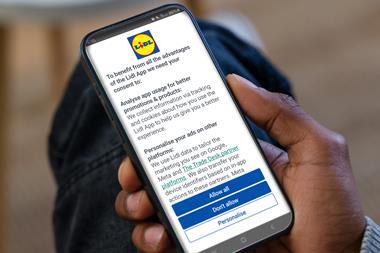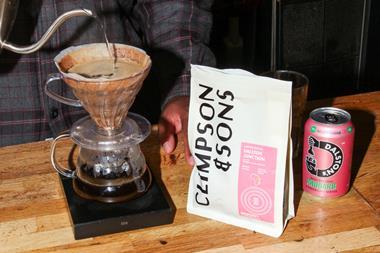Is Sainsbury’s obsession with improving its supply chain and revamping stores simply a case of rearranging the deckchairs as the ship sinks or can the ‘Titanic of grocery’ chart a profitable new course? Liz Hamson reports
Sir Peter Davis parried the inevitable questions about Sainsbury’s woes with his usual panache after delivering a speech on “the changes in food retailing” at the British Council of Shopping Centres’ annual conference in Birmingham last week.
The redoubtable chief executive is not expected to escape quite so lightly when he announces the company’s interim results to the City this Wednesday. Analysts are anticipating like-for-like sales at best only slightly up, at worst even lower than the miserable 0.2% slump JS reported in last month’s trading statement which set it 6% to 10% adrift of its rivals. They are also warning that the group will need to pull off some pretty impressive Christmas sales to meet its £740m to £750m profit target.
“In every sphere, they’ve spent a lot of money, made a lot of promises and delivered rather less,” says one analyst. “The question is why, in what’s been a golden year for grocers, has Sainsbury had none of it?”
Recently the Sainsbury rumour mill has gone into overdrive. There have been those asking whether Sir Peter will have to go before it can sign up a new chief executive. Speculation that Philip Green and Allan
Leighton were lining up a bid was swiftly followed by suggestions that Sainsbury family members were softening their stance on selling their shares. Then came news that JS was struggling to get to grips with the dependencies required to supply its new automated depots (The Grocer, October 11). Soon after came yet more bid rumours, this time involving KKR and Archie Norman, and reports that the main reason it had not yet identified a new chief executive was that no one was willing to work under Sir Peter. Never mind the latest reports of a falling out with Jeff Banks over clothing.
Some reports are examples of what one weary Sainsbury insider describes as “mischief making”. But there’s no smoke without fire and the consensus is that the fire is a darn sight bigger than anything Marks & Spencer had to put out.
At the BCSC conference, Sir Peter talked of the “challenges” the group had faced since it embarked on its recovery programme two and a half years ago. “The first strand in our recovery was to improve our IT systems. We had out-of-date systems and our supply chain was out of date. Within 12 months, we’ll have four new automated depots.”
Ironically, it is precisely this ambitious and costly refurbishment programme that analysts see as a key problem. They argue that Sainsbury has become so fixated with its infrastructure, it is neglecting customers.
“They’ve gambled and, to a degree, lost,” says Baird analyst Paul Smiddy. “They have consistently underplayed their problems and overplayed the success of their change transformation programme.”
The supply chain overhaul has also failed to impress some suppliers, with one recently describing the new system as “Kafkaesque”, while another claimed he was told to deliver goods to a depot that no longer existed.
Sainsbury’s efforts to stem the criticism have not been helped by its inability to find a chief executive after almost nine months searching. The view is that if it could announce someone before Christmas it could get 2004 off to a fresh start. There is just one obstacle. “They would have a wider candidate field if they had a non-executive chairman,” says one analyst bluntly.
According to a Sainsbury spokeswoman, the company has only “bought an option” on Sir Peter’s time. Nevertheless, several
potential candidates - and the names in the frame have ranged from Archie Norman to Justin King - are understood to have turned the job down because of his continuing role. Calls are now mounting for Sir Peter to go sooner rather than later.
Whoever accepts the job has a huge task ahead, not least in working out exactly what the brand stands for. Should Sainsbury be the food specialist or build its non-food offer? Should it try to match the aspirations for the brand with the store portfolio or radically re-jig the portfolio to fit the brand?
At the BCSC conference Sir Peter argued that in a market dominated by EDLP players, Sainsbury’s emphasis on quality and range was its unique selling point. He espoused the big opportunity of non-food while meeting customer expectations of food price rises below the rate of inflation. He also talked of the need for Sainsbury to sell quality food to high spenders, pointing out that Sainsbury “typically offers 15-20% more choice and generally people are prepared to pay for it”.
The two may not be mutually exclusive, but leading analysts see them as evidence of a lack of strategic clarity that is damaging the brand.
One says: “The essence of Sainsbury’s brand problem is that half the world thinks it’s bloody brilliant, the other half don’t want anything to do with it.”
Targeting higher spenders is also high risk, adds Teather & Greenwood’s David Stoddart. He says: “They have made some gains in terms of cost cutting that will keep them on target profit-wise, but they’ve gone for the above mid-market spenders. Is there a market there? Yes. But is it big enough to support the infrastructure and scale of Sainsbury’s business?”
Teething troubles are almost inevitable for a business that is trying to implement a seven-year supply chain programme in just three years. It would be churlish to suggest that everything is going wrong. There is broad approval for its venture into non-food, for instance. And if Sainsbury can iron out the problems with its fulfilment factories it will boast the most sophisticated supply chain in the UK.
But even if Sainsbury’s interim results are better than expected on Wednesday, and a new chief executive is appointed soon, the question remains: is the supermarket chain many in the City are now calling the Titanic of the sector doing enough to prevent itself from hitting the iceberg?
Sir Peter Davis parried the inevitable questions about Sainsbury’s woes with his usual panache after delivering a speech on “the changes in food retailing” at the British Council of Shopping Centres’ annual conference in Birmingham last week.
The redoubtable chief executive is not expected to escape quite so lightly when he announces the company’s interim results to the City this Wednesday. Analysts are anticipating like-for-like sales at best only slightly up, at worst even lower than the miserable 0.2% slump JS reported in last month’s trading statement which set it 6% to 10% adrift of its rivals. They are also warning that the group will need to pull off some pretty impressive Christmas sales to meet its £740m to £750m profit target.
“In every sphere, they’ve spent a lot of money, made a lot of promises and delivered rather less,” says one analyst. “The question is why, in what’s been a golden year for grocers, has Sainsbury had none of it?”
Recently the Sainsbury rumour mill has gone into overdrive. There have been those asking whether Sir Peter will have to go before it can sign up a new chief executive. Speculation that Philip Green and Allan
Leighton were lining up a bid was swiftly followed by suggestions that Sainsbury family members were softening their stance on selling their shares. Then came news that JS was struggling to get to grips with the dependencies required to supply its new automated depots (The Grocer, October 11). Soon after came yet more bid rumours, this time involving KKR and Archie Norman, and reports that the main reason it had not yet identified a new chief executive was that no one was willing to work under Sir Peter. Never mind the latest reports of a falling out with Jeff Banks over clothing.
Some reports are examples of what one weary Sainsbury insider describes as “mischief making”. But there’s no smoke without fire and the consensus is that the fire is a darn sight bigger than anything Marks & Spencer had to put out.
At the BCSC conference, Sir Peter talked of the “challenges” the group had faced since it embarked on its recovery programme two and a half years ago. “The first strand in our recovery was to improve our IT systems. We had out-of-date systems and our supply chain was out of date. Within 12 months, we’ll have four new automated depots.”
Ironically, it is precisely this ambitious and costly refurbishment programme that analysts see as a key problem. They argue that Sainsbury has become so fixated with its infrastructure, it is neglecting customers.
“They’ve gambled and, to a degree, lost,” says Baird analyst Paul Smiddy. “They have consistently underplayed their problems and overplayed the success of their change transformation programme.”
The supply chain overhaul has also failed to impress some suppliers, with one recently describing the new system as “Kafkaesque”, while another claimed he was told to deliver goods to a depot that no longer existed.
Sainsbury’s efforts to stem the criticism have not been helped by its inability to find a chief executive after almost nine months searching. The view is that if it could announce someone before Christmas it could get 2004 off to a fresh start. There is just one obstacle. “They would have a wider candidate field if they had a non-executive chairman,” says one analyst bluntly.
According to a Sainsbury spokeswoman, the company has only “bought an option” on Sir Peter’s time. Nevertheless, several
potential candidates - and the names in the frame have ranged from Archie Norman to Justin King - are understood to have turned the job down because of his continuing role. Calls are now mounting for Sir Peter to go sooner rather than later.
Whoever accepts the job has a huge task ahead, not least in working out exactly what the brand stands for. Should Sainsbury be the food specialist or build its non-food offer? Should it try to match the aspirations for the brand with the store portfolio or radically re-jig the portfolio to fit the brand?
At the BCSC conference Sir Peter argued that in a market dominated by EDLP players, Sainsbury’s emphasis on quality and range was its unique selling point. He espoused the big opportunity of non-food while meeting customer expectations of food price rises below the rate of inflation. He also talked of the need for Sainsbury to sell quality food to high spenders, pointing out that Sainsbury “typically offers 15-20% more choice and generally people are prepared to pay for it”.
The two may not be mutually exclusive, but leading analysts see them as evidence of a lack of strategic clarity that is damaging the brand.
One says: “The essence of Sainsbury’s brand problem is that half the world thinks it’s bloody brilliant, the other half don’t want anything to do with it.”
Targeting higher spenders is also high risk, adds Teather & Greenwood’s David Stoddart. He says: “They have made some gains in terms of cost cutting that will keep them on target profit-wise, but they’ve gone for the above mid-market spenders. Is there a market there? Yes. But is it big enough to support the infrastructure and scale of Sainsbury’s business?”
Teething troubles are almost inevitable for a business that is trying to implement a seven-year supply chain programme in just three years. It would be churlish to suggest that everything is going wrong. There is broad approval for its venture into non-food, for instance. And if Sainsbury can iron out the problems with its fulfilment factories it will boast the most sophisticated supply chain in the UK.
But even if Sainsbury’s interim results are better than expected on Wednesday, and a new chief executive is appointed soon, the question remains: is the supermarket chain many in the City are now calling the Titanic of the sector doing enough to prevent itself from hitting the iceberg?


















No comments yet